
John Anthony West. Courtesy and copyright of John Anthony West
Schwaller also speculated that ancient Egypt owed its core knowledge to a lost civilization that flourished in prehistoric times. As evidence of this earlier origin, Schwaller asserted that the weathering of the Sphinx was caused by water, not by wind and sand. During the transition from the last ice age to the onset of present desert conditions, Egypt experienced rainfall and flooding heavier than any that has occurred since then. Heavy rains fell in intervals between 10,000 and 3000 BCE and then tapered off to their current level of about 2 cm per year by the end of the third millennium. Schwaller dated the Sphinx to this transitional climate or earlier, and West thought that closer geological study of the Sphinx might provide scientific confirmation.
In his initial study, Gauri had supposed that groundwater leeching upward inside the rock was the cause of salt exfoliation to the Sphinx. West pointed out that if the Sphinx had stopped eroding from the New Kingdom onward, this could not have been the reason for the erosion. The water table had risen since the New Kingdom and groundwater should have continued to leech upward, causing further damage. Modern development had caused a dramatic rise in the water table during the twentieth century and Gauri was correct to warn of the danger this posed to the Sphinx (the water table has since been brought down). But something else was responsible for the erosion of the Sphinx before the twentieth century.
West thought the archaeological evidence left open the possibility of an earlier date. The oldest facing blocks on the monument were of a large size previously thought to have been applied at the time of the original carving (subsequent repairs to the Sphinx used smaller blocks and bricks). Lehner was the first to suggest that the large blocks were a later addition. West realized that if the date of application was not in fact certain, the blocks might have been Old Kingdom repairs to an already-eroded Sphinx.
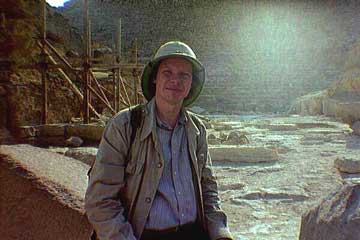
Professor Robert M. Schoch. Courtesy and copyright of Robert M. Schoch
In 1989, West invited Dr. Robert Schoch, an associate professor and geologist at Boston University, to examine the Sphinx. Schoch was skeptical of an earlier age but agreed to visit the monument in 1990. Preliminary observations prompted him to return in 1991 with Dr. Thomas Dobecki, a private geophysicist, who took soundings of the rock below the enclosure floor. The tests were to determine non-invasively whether the rock underneath showed evidence that could be interpreted as weathering, and if so, to what depths. Schoch reported the results along with his observations of the surface geology in several articles.
Robert M. Schoch, " Redating the Great Sphinx of Giza," originally published in KMT: A Modern Journal of Ancient Egypt, Vol. 3, No. 2 (Summer 1992), pp. 52-59, 66-70.
Thomas L. Dobecki and Robert M. Schoch, "Seismic Investigations in the Vicinity of the Great Sphinx of Giza, Egypt," Geoarchaeology, Vol. 7, No. 6 (1992), pp. 527-544.
West had supposed that Nile river flooding was the likely cause of any water weathering of the Sphinx and its enclosure. Schoch determined, however, that flood levels were not high enough to produce the erosion visible on the Sphinx and its walls. The exposed surface rock, with its deep roundedness and fissuring (Fig. 3.1 below), suggested to Schoch instead that the Sphinx and its walls had eroded from rainfall. In their survey of the enclosure floor (Fig. 3.2 below), Schoch and Dobecki took soundings along four lines: one parallel to the north side of the Sphinx body (S1), one parallel to the south side (S2), one behind the monument and perpendicular to the first two (S3), and one in front of the Sphinx (S4) parallel to the one in back. A sledgehammer striking a metal plate at shotpoints along each line produced the sound waves, and monitoring equipment recorded the wave velocities (in meters per second) as they bounced back from the rock below. The soundings disclosed a region of lower velocities between 1.0-1.5 meters deep along the S3 line and 2.0-2.5 meters in depth along the S1 and S2 lines, falling to 3-4 meters deep along the S4 line (Fig. 3.3 below). Below this region lay bedrock that returned higher velocities. Schoch believed that the region of lower velocities did not follow the natural bedding of the rock. Since unweathered rock returns higher velocities than weathered rock, Schoch interpreted the lower-velocity region as weathered.
Neither the erosion to the Sphinx and its walls, nor the lower velocities in the rock below the enclosure floor, suggested when the floor was first exposed. But the lower-velocity region measured by the S3 line in back was only half as deep as the regions measured by the two flank lines, and the transition to the flank lines was relatively abrupt. To Schoch, this suggested that the area behind the Sphinx was cut back at a later time. On the assumption that the back was cleared by Khafra, Schoch estimated that the rest of the floor was between 50 and 100 percent as old, or excavated between 7000 and 4750 BCE. Schoch noted that the Sphinx could have dated before 7000 if the rate of weathering was non-linear, meaning that weathering might have taken longer to penetrate the subsurface as the mass of overhead rock increased.
In a 1992 article for KMT, a magazine reporting developments in Egyptology to a general audience, Schoch summarized his surface and subsurface findings. He also addressed the conventional view of how the Sphinx had weathered, agreeing that salt exfoliation induced by moisture in the atmosphere was a factor in the past, although modern air pollution had probably accelerated the process. Wind-blown sand was also a factor in weathering. But Schoch argued that wind-blown sand typically produces a kind of erosion characterized by sharper lines and jaggedness, not by the smoothness or rounding visible on the Sphinx and its walls. As an example of wind weathering, he pointed to the tomb of Debehen, four hundred yards southwest of the Sphinx (Fig. 3.5). If the Sphinx was no older than the Old Kingdom, Schoch believed, it should display a more jagged appearance and not the more rounded weathering profile visible on the western enclosure wall (Fig. 3.4 above) and on the western end of the southern enclosure wall (Fig. 3.1 above). Schoch believed that the heavy rains at the end of the prehistoric period had produced the rounded profiles on the Sphinx and its enclosure walls.
Schoch also suggested some other evidence to date the monument to an earlier time. Parts of the Khafra Valley Temple showed weathered limestone core blocks behind harder granite facing. Schoch argued that the granite facing stones had been fitted to the eroded profile of the core blocks; if the facing stones were of Old Kingdom origin, the core blocks were much older. To the objection that there was no known civilization in Egypt before 4000 BCE, he pointed to Jericho and other sites in the wider region that had stone architecture as early as the ninth millennium BCE.
At a meeting of the American Association for the Advancement of Science in February 1992, Schoch and Dobecki debated Mark Lehner and K. Lal Gauri before an audience of several hundred.[3] Lehner underlined the absence of any evidence of civilization or complex society in Egypt during the millennia proposed by Schoch and West for the original carving of the Sphinx. But Lehner and Gauri did not more fully engage West and Schoch; they would do so only in later publications after having had more time to consider the geological and archaeological evidence for dating the Sphinx to Khafra.
In an hour-long privately-produced documentary, "The Mystery of the Sphinx", broadcast on the American NBC television network on November 10, 1993, West and Schoch presented the geological evidence in favor of their earlier dating to an audience of about thirty million people. During the program, West also presented the work of Detective Frank Domingo, a senior forensic artist for the New York City Police Department, who compared the face on the Sphinx with the face on the statue of Khafra in the Cairo Museum. Domingo determined that the face on the Sphinx was not the face of Khafra; the Sphinx had a prognathic jaw more typical of an African from farther south. The "Mystery of the Sphinx" program received an Emmy Award for Research and brought the West-Schoch findings to public notice. Controversy followed. Notes
1. Mark Lehner with James P. Allen and K. Lal Gauri, "The ARCE Sphinx Project: A Preliminary Report," The ARCE Newsletter, No. 112 (1980), pp. 17-18.
2. At the time, however, one scholar who did not accept Schwaller's larger conclusions credited him with insights missed by other scholars. See the review by Bernard V. Bothmer of the abridged version of Schwaller's book in the Journal of Near Eastern Studies, Vol. 11, No. 2 (April 1952), pp. 151-152.
3. For a brief report of the AAAS exchange, see Elizabeth Culotta, "Sphinx Riddle Put to Rest?" Science, Vol. 255, No. 5046 (14 February 1992), p. 793. For a more detailed account by an eyewitness in the audience, see Paul William Roberts, River in the Desert (New York: Random House, 1993), pp. 127-135.
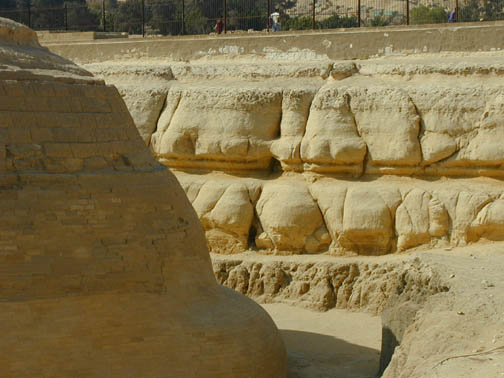
Fig. 3.1. The western end of the south wall of the Sphinx enclosure. Courtesy and copyright of John Anthony West.
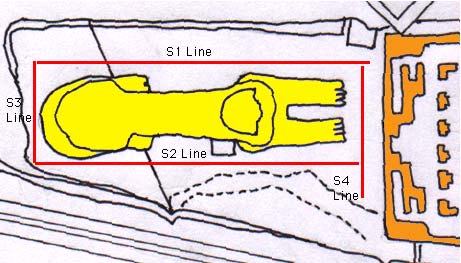
Fig. 3.2. Overview of the four sounding lines (in red) that Schoch and Dobecki took in 1991 around the Sphinx.
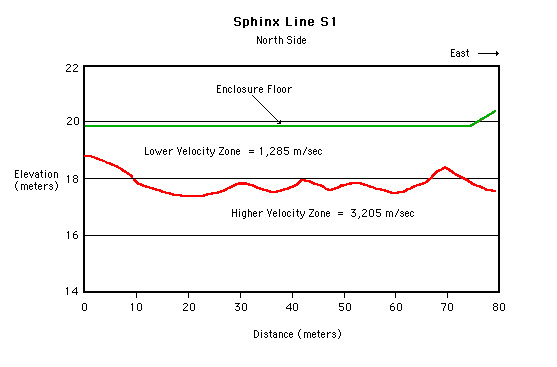
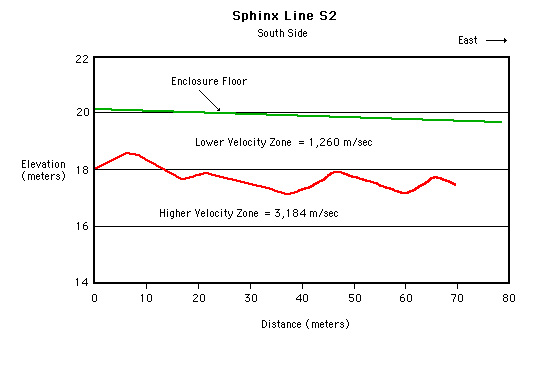
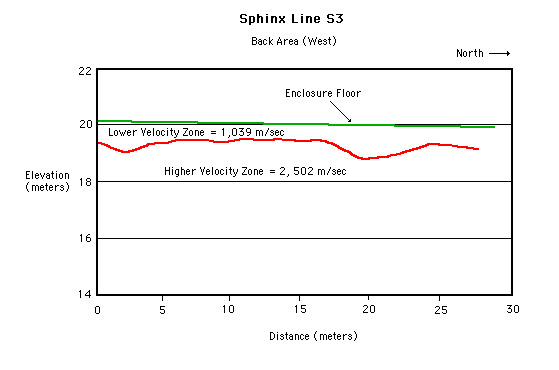
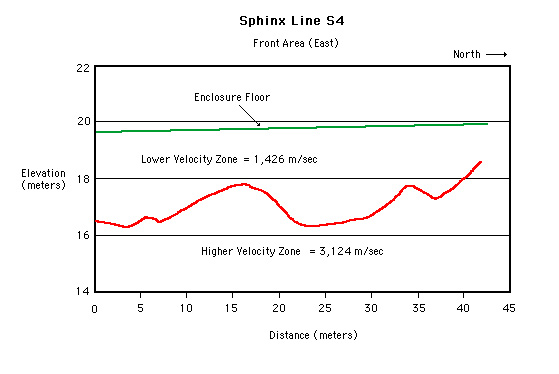
Fig. 3.3. Graphs showing the depths of velocities in the subsurface rock recorded by Schoch and Dobecki. The green line in each diagram is the ground surface. Lower-velocity rock lay between the ground level and the red line in each diagram. Higher-velocity rock lay below the red line. Source: Thomas L. Dobecki and Robert M. Schoch, "Seismic Investigations in the Vicinity of the Great Sphinx of Giza, Egypt," Geoarchaeology, Vol. 7, No. 6 (1992), p. 534.
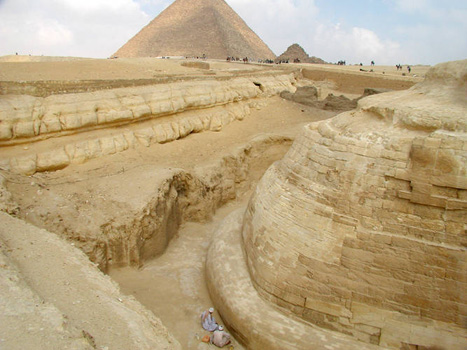
Fig. 3.4. The back terrace shelf of the Sphinx enclosure below the western wall. Schoch believed that the passageway behind the Sphinx was a later cutback of this shelf. Courtesy and copyright of Jon Bodsworth
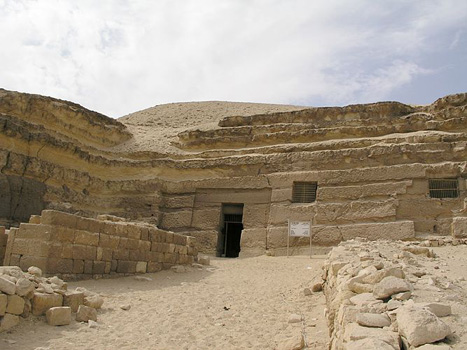
Fig. 3.5. Debehen's Tomb. Sharp jagged weathering can be seen on the rock face above the entrance. Courtesy and copyright of Jon Bodsworth
Launching a Controversy
West and Schoch defended their findings initially before two professional gatherings. At the October 1991 meeting of the Geological Society of America, the two conducted a "poster session" in which they sat at a table in a hall (with other scientists holding poster sessions of their own) and explained their work to interested GSA members who passed by. Although not formally endorsing an earlier Sphinx, the scientists who stopped at the West-Schoch table responded with interest, and about seventy asked to be notified of further research.
Go to next page.
Go to last page.
Go to index page.